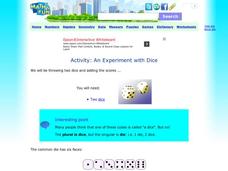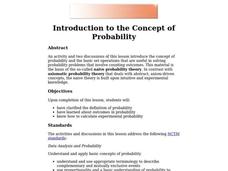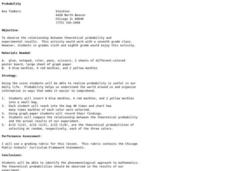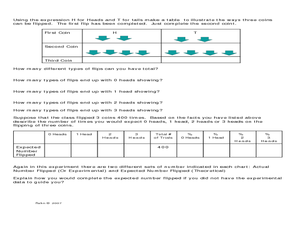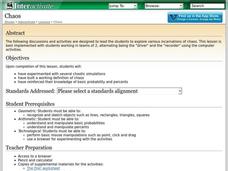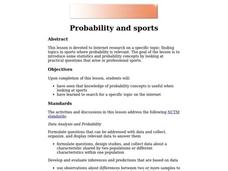Curated OER
Rolling Twice
Rolling dice is the best way to show your learners how probability comes in to play. Although this lesson does not specify an activity, your mathematicians can try this probability with real dice to calculate their experimental...
Curated OER
Activity: An Experiment with Dice
Roll the dice with this activity and teach young mathematicians about probability. Record outcomes for rolling two number cubes in order to determine what is most likely to happen. Graph the data and investigate patterns in the results,...
Curated OER
Data Analysis and Froot Loops
Use this probability and graphing lesson to have your learners work with a partner to make a necklace out of Froot Loops. They record the cereal colors randomly chosen and strung, graph their data, then use a ratio formula to determine...
Curated OER
Introduction to the Concept of Probability
Middle and high schoolers have a clarified definition of probability, they explore about outcomes in probability and how to calculate experimental probability. They use computers to learn about probability.
Curated OER
Probability- Based Bingo Lesson Plan
Statisticians play a game of Bingo to discover the meaning of probability. They are given 12 markers to distribute across the numbers 1-12 on their playing mat. As a pair of dice is rolled, markers are removed from the playing mat. The...
Curated OER
Math Regents Exam Questions: Theoretical and Experimental Probability
In this probability activity, students solve 19 multiple choice and short answer questions. Students find the theoretical and experimental probability of various scenarios.
Curated OER
Concept: Dice Probabilities
In this probability worksheet, students roll dice to determine the experimental probability of rolling each number on a die. The experiment is repeated using a dice rolling application on their computer. Students find the theoretical...
Curated OER
Probability
Students explore probability. In this probability lesson, students define theoretical probability and experimental probability. Students predict outcomes of hands on activities using coins and colored tiles, complete a chart...
Curated OER
Probability of Childhood Games
Students explore the concept of probability. In this probability lesson, students find the probability of certain situations including spinning a spinner, drawing marbles from a bag, and rolling a dice.
Curated OER
Probability
Sixth graders explore theoretical and experimental probability. In this probability lesson, 6th graders participate in several hands-on activities involving the comparison of theoretical probability to the actual results. Games include...
Curated OER
Probability
Students explore the concept of probability. In this probability lesson, students flip coins and draw marbles out of a bag to determine probabilities of a particular outcome. Students discuss the differences between experimental and...
Curated OER
Why Isn't It 50-50
Young scholars comprehend the difference between the outcome of the experiment and the outcome that they expected. They analyze outcome of probability experiment and compare theoretic and empirical results. Pupils discuss the difference...
Curated OER
Playing With Probability
Students rotate through work stations where they compute problems of theoretical and experimental probability. In this probability lesson plan, students use simulations of a lottery system.
Curated OER
Let's Flip a Coin
In this probability instructional activity, learners use a TI graphing calculator to simulate flipping a coin and compare their results (experimental probability) to the expected results (theoretical probability). The five page...
Curated OER
Probability
Sixth graders explore the concept of probability. In this probability lesson, 6th graders collaborate to collect spinner data based on the likelihood of spinning odd and even numbers. Students complete 2 other probability activities and...
Curated OER
Chaos
Students explore the concept of probability. In this probability lesson, students use a applet that demonstrates chaos and probability of spread for a forest fire. Students also play applets about the Game of Life and Rabbits and Wolves,...
Curated OER
Phenomenological Probability
Students explore the concept of theoretical and experimental probability. In this theoretical and experimental probability lesson, students roll dice, draw marbles out of a bag, and draw a card from a deck of cards. Students perform each...
Curated OER
Theoretical and Empirical Probabilities
In this probability worksheet, students determine the theoretical probability of given events. Topics include choosing a card at random, number cubes, and fractions. This one-page worksheet contains ten problems.
Curated OER
Theoretical Probability
In this math instructional activity, students investigate the ratio comparing the number of ways an event can occur using theoretical probability.
Curated OER
What is Probability? Original Lesson Plan
Pupils predict, using a fraction or a ratio, the possibility of an event happening and place that fraction or ratio on a Likelihood Line. In Part Two of the lesson, they conduct an experiment to determine theoretical and experimental...
Curated OER
Probability Lesson Plan
Your learners will examine probability through experiments and dice games. Using a computer, your class will perform simple experiments to collect and analyze data to determine the probability of different experimental results. Young...
Curated OER
Probability and Sports
Students research topics on the internet where probability is relevant. Students study statistics and probability concepts by looking at practical questions that arise in professional sports.
Curated OER
Calculating Theoretical & Experimental Probability
Students explore the concept of experimental and theoretical probability. In this experimental and theoretical probability lesson, students collect data by conducting a survey of their classmates. Students compare their data and discuss...
Curated OER
Designing Models to Simulate Actual Events Using a Table of Random Digits
Learners design models to simulate actual events using a tale of random digits. They estimate the likelihood of a particular outcome using results of simulation. Students investigate the uses of statistical methods to analyze data.



